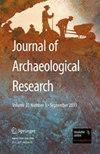从史前安第斯冶金中提取见解:政治组织,区域间联系和仪式意义
IF 4.1
1区 历史学
Q1 ANTHROPOLOGY
引用次数: 13
摘要
史前安第斯山脉的金属生产涉及一系列政治、经济和仪式关系,这些关系日益成为考古调查的重点。指导最近研究的一个主题是冶金学与政治组织之间的联系,包括金属生产的起源,其与社会政治复杂性的关系,以及金属生产组织的变化如何反映和塑造历时性的政治变革。第二个主题是使用金属来识别和询问区域间的联系。不同合金和金属同位素的流通模式,以及技术转让,提供了对安第斯地区前西班牙人维持的经济和政治联系的变化格局的洞察。最后一个主题是安第斯冶金的仪式和意义,在这里我探讨了采矿、提取冶金和金属制品生产的各个阶段是如何为金属制品增加多层意义和价值的。古代安第斯山脉的冶金以不同的方式在不同的时间和空间中运作,可以刺激政治复杂性,推动地缘政治扩张和新主体群体的整合,区分个人和群体,将人们彼此联系起来,与景观联系起来,并利用超自然的力量。本文章由计算机程序翻译,如有差异,请以英文原文为准。
Extracting Insights from Prehistoric Andean Metallurgy: Political Organization, Interregional Connections, and Ritual Meanings
Metal production in the prehistoric Andes entailed an array of political, economic, and ritual relationships that are increasingly the focus of archaeological investigation. One theme directing recent research is the link between metallurgy and political organization, including the origins of metal production, its relationship to sociopolitical complexity, and how shifts in the organization of metal production reflect and shape diachronic political transformations. A second theme is the use of metals to identify and interrogate interregional connections. Patterns in the circulation of different alloys and metal isotopes, as well as the transfer of technology, provide insight into the shifting constellations of economic and political connections maintained by prehispanic Andean populations. A final theme is ritual and meaning in Andean metallurgy, where I explore how the stages of mining, extractive metallurgy, and the production of metal objects added multivalent layers of meaning and value to metal artifacts. Operating in distinct ways across time and space, metallurgy in the ancient Andes could stimulate political complexity, drive geopolitical expansion and the integration of new subject populations, differentiate individuals and groups, connect people to one another and to the landscape, and harness the power of the numinous.
求助全文
通过发布文献求助,成功后即可免费获取论文全文。
去求助
来源期刊

Journal of Archaeological Research
Multiple-
CiteScore
10.20
自引率
7.90%
发文量
9
期刊介绍:
Journal of Archaeological Research publishes the most recent international research summaries on a broad range of topics and geographical areas. The articles are intended to present the current state-of-the-discipline in regard to a particular geographic area or specific research topic or theme. This authoritative review journal improves access to the growing body of information and literature through the publication of original critical articles, each in a 25-40 page format.2-Year Impact Factor: 4.056 (2017) 5-Year Impact Factor: 4.512 (2017)2 out of 85 on the Anthropology listIncluded in the European Reference Index for the Humanities (ERIH) PLUS The European Reference Index for the Humanities and the Social Sciences (ERIH PLUS) was created and developed by European researchers under the coordination of the Standing Committee for the Humanities (SCH) of the European Science Foundation (ESF). https://dbh.nsd.uib.no/publiseringskanaler/erihplus/about/indexSCImago Journal and Country Rank (SJR) 2018: 1.7102 out of 263 on the Archeology (Arts and Humanities) list3 out of 254 on the Archeology list2 out of 131 on the General Arts and Humanities listSJR is a measure of the journal’s relative impact in its field, based on its number of citations and number of articles per publication year.Source Normalised Impact per Paper (SNIP) 2018: 2.112The SNIP measures contextual citation impact by weighting citations based on the total number of citations in a subject field. The impact of a single citation is given higher value in subject areas where citations are less likely, and vice versa.CiteScore 2018: 3.86Rated ''A'' in the Australian Research Council Humanities and Creative Arts Journal List. For more information, visit: http://www.arc.gov.au/era/journal_list.htm
SCImago Journal and Country Rank (SJR) 2011 1.227 Archeology 1 out of 96 Archeology (Arts and Humanities) 1 out of 59 Arts and Humanities (miscellaneous) 1 out of 243
 求助内容:
求助内容: 应助结果提醒方式:
应助结果提醒方式:


